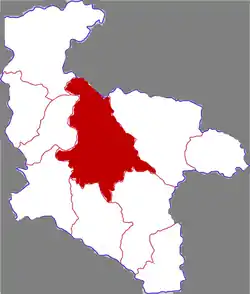Hanbin District
Hanbin District (simplified Chinese: 汉滨区; traditional Chinese: 漢濱區; pinyin: Hànbīn Qū) is a district of the City of Ankang in Shaanxi Province, China and the seat of the city's government. It has a population of 886,393 as of 2019[1] and an area of 3,645.91 km2. With forests covering 68.8% of its land,[1] the district abounds in natural resources and remains a popular destination of tourism in Shaanxi.
Hanbin
汉滨区 | |
|---|---|
 Hanbin in Ankang | |
.png.webp) Ankang in Shaanxi | |
| Coordinates: 32°41′43″N 109°01′36″E | |
| Country | People's Republic of China |
| Province | Shaanxi |
| Prefecture-level city | Ankang |
| Government | |
| • Party Secretary | Wang Xiaocheng (Chinese Communist Party) |
| • District Mayor | Fan Chuanbin |
| • District Congress Director | Li Senwen |
| • CPPCC District Chair | Li Jianfei |
| Area | |
| • District | 3,646 km2 (1,408 sq mi) |
| • Urban | 45 km2 (17 sq mi) |
| Population (2018)[1] | |
| • District | 1,020,000 |
| • Density | 280/km2 (720/sq mi) |
| Time zone | UTC+8 (China standard time) |
| Postal code | 725000-725099 |
| Area code | 0915 |
| Licence plates | 陕G |
| GDP[1] | 2019 |
| • Total | ¥38.095 billion |
| • Per capita | ¥43040 |
| Website | www |
Between the Qinling and the Daba Mountains, Hanbin District is centrally located in Ankang, bordering the counties Ningshan, Hanyin, and Ziyang on the west, Langao and Pingli on the south, Xunyang on the east, and Zhen'an on the north. Three expressways (G65, G7011, and G4213), three railways (Yangpingguan-Ankang, Xiangyang-Chongqing, Xi'an-Ankang) and an airport make Hanbin a transportation hub in the Shaannan (Chinese: 陕南) region.
Human settlement in what is called Hanbin District today dates back to the Neolithic period over 7,000 years ago.[2] In 312 BC, a Xicheng County (Chinese: 西城縣) was instituted by the Qin state (Chinese: 秦國) here, marking the beginning of the area's countyhood.[2]: §2 [3] From the 4th century BC to the late 20th century, it was a county under various dynasties and regimes, until being established as a county-level city in 1988,[4] and finally became a district of the prefectural City of Ankang in 2000.[5]
Administrative divisions
As 2019, Hanbin District is divided to 4 subdistricts and 24 towns.[6]
- Subdistricts
|
|
- Towns
|
|
|
References
- "Hanbin District Yearbook 2019". Hanbin District People's Government (in Chinese). 24 July 2020. Retrieved 7 October 2020.
- Ankang Municipal Commission on Gazetteer Publication (1989). "Chapter 31 Cultural Artifacts". Ankang County Gazetteer (in Chinese). Xi'an.
{{cite book}}: CS1 maint: location missing publisher (link) - Zheng, Qian; Wang, Senwen (1815). "輿地考第一上". Ankang County Gazetteer (in Chinese). Retrieved 7 October 2020.
- Ministry of Civil Affairs of the People's Republic of China (24 May 1988). "Written approval for Shaanxi Province to revoke the status of Yulin County, Ankang County, and Shang County and establish county-level Yulin City, Ankang City, and Shangzhou City" (PDF). Gazette of the State Council of the People's Republic of China (in Chinese). Beijing (570): 574–575. Retrieved 7 October 2020.
- State Council of the People's Republic of China (23 June 2000). "Written Approval of the State Council to Shaanxi Province on Revoking the Status of Ankang Prefecture and Establishing Prefecture-Level Ankang City". Gazette of the State Council of the People's Republic of China (in Chinese) (995). Retrieved 7 October 2020.
- "统计用区划代码 www.stats.gov.cn" (in Chinese). XZQH. Retrieved 2021-01-02.